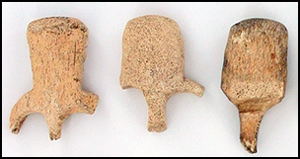Crossref Citations
This article has been cited by the following publications. This list is generated based on data provided by Crossref.
Lew-Levy, Sheina
Milks, Annemieke
Lavi, Noa
Pope, Sarah M.
and
Friesem, David E.
2020.
Where innovations flourish: an ethnographic and archaeological overview of hunter–gatherer learning contexts.
Evolutionary Human Sciences,
Vol. 2,
Issue. ,
Grindle, E. Dalyn
Rick, Torben C.
Dagtas, Nihan D.
Austin, Rita M.
Wellman, Hannah P.
Gobalet, Kenneth
and
Hofman, Courtney A.
2021.
Green or white? Morphology, ancient DNA, and the identification of archaeological North American Pacific Coast sturgeon.
Journal of Archaeological Science: Reports,
Vol. 36,
Issue. ,
p.
102887.
Acosta, Alejandro A.
Buc, Natacha
Loponte, Daniel M.
Gascue, Andrés
Silvestre, Romina
and
Bortolotto, Noelia
2021.
The atlatl among prehispanic hunter-gatherer from the southeastern Lowlands, South America.
Journal of Archaeological Science: Reports,
Vol. 37,
Issue. ,
p.
103001.
Dorland, Steven G.H.
2021.
Let's start with something Small: An evaluation of social learning and scaling practices in Great Lakes potting communities during the Late Woodland.
Journal of Anthropological Archaeology,
Vol. 62,
Issue. ,
p.
101287.
Riede, Felix
Walsh, Matthew J.
Nowell, April
Langley, Michelle C.
and
Johannsen, Niels N.
2021.
Children and innovation: play, play objects and object play in cultural evolution.
Evolutionary Human Sciences,
Vol. 3,
Issue. ,
Milks, Annemieke
Lew-Levy, Sheina
Lavi, Noa
Friesem, David E.
and
Reckin, Rachel
2021.
Hunter-gatherer children in the past: An archaeological review.
Journal of Anthropological Archaeology,
Vol. 64,
Issue. ,
p.
101369.
Wellman, Hannah P.
2022.
Fur or food? Native American use of sea otters (Enhydra lutris) on the Oregon coast prior to European contact and extirpation.
Journal of Archaeological Science: Reports,
Vol. 43,
Issue. ,
p.
103485.
Riede, Felix
Lew-Levy, Sheina
Johannsen, Niels N.
Lavi, Noa
and
Andersen, Marc Malmdorf
2022.
Toys as Teachers: A Cross-Cultural Analysis of Object Use and Enskillment in Hunter–Gatherer Societies.
Journal of Archaeological Method and Theory,
Garnett, Justin
and
Sellet, Frederic
2023.
Exploring the Possible Function of Paleolithic Open Rings as Spearthrower Finger Loops.
Journal of Paleolithic Archaeology,
Vol. 6,
Issue. 1,
Milks, Annemieke
2024.
Hunting lessons.
Hunter Gatherer Research,
Vol. 10,
Issue. 2,
p.
265.
Milks, Annemieke
Hoggard, Christian
and
Pope, Matt
2024.
Reassessing the Interpretative Potential of Ethnographic Collections for Early Hunting Technologies.
Journal of Archaeological Method and Theory,
Vol. 31,
Issue. 3,
p.
1129.
Wellman, Hannah P.
Spitzer, Megan D.
and
Rick, Torben C.
2024.
Archaeology and ethnobiology of Late Holocene bird remains from the northern Oregon coast.
International Journal of Osteoarchaeology,
Acosta, Alejandro
Buc, Natacha
Rombolá, Lucía T.
and
Loponte, Daniel
2024.
Small artifacts among the hunter-gatherers of the southern La Plata Basin.
Archaeological and Anthropological Sciences,
Vol. 16,
Issue. 2,
Riede, Felix
and
Lombard, Marlize
2024.
Hunting with poisoned arrows during the Terminal Pleistocene in Northern Europe? A tip cross-sectional area assessment and list of potential arrow poison ingredients.
Journal of Archaeological Science: Reports,
Vol. 59,
Issue. ,
p.
104757.
Buchanan, Briggs
Hamilton, Marcus J.
and
Walker, Robert S.
2025.
A New Method for Classifying Dart and Arrow Projectile Points.
American Antiquity,
p.
1.
Wellman, Hannah P.
Zhang, Hua
Yang, Dongya Y.
Evans, Zara D.
Miner, Maxwell
and
Speller, Camilla F.
2025.
Native American use of cetaceans in pre-contact Oregon: Biomolecular and taphonomic analyses illuminate human–cetacean relationships.
The Journal of Island and Coastal Archaeology,
Vol. 20,
Issue. 2,
p.
472.


